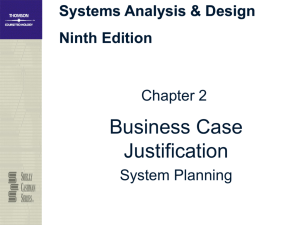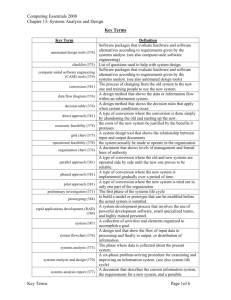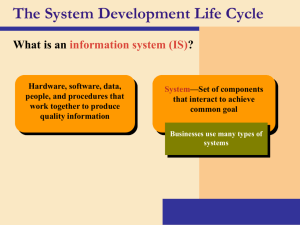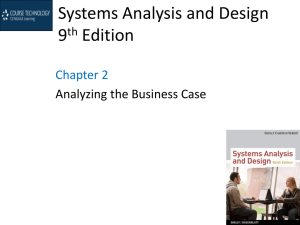Slide 1
advertisement
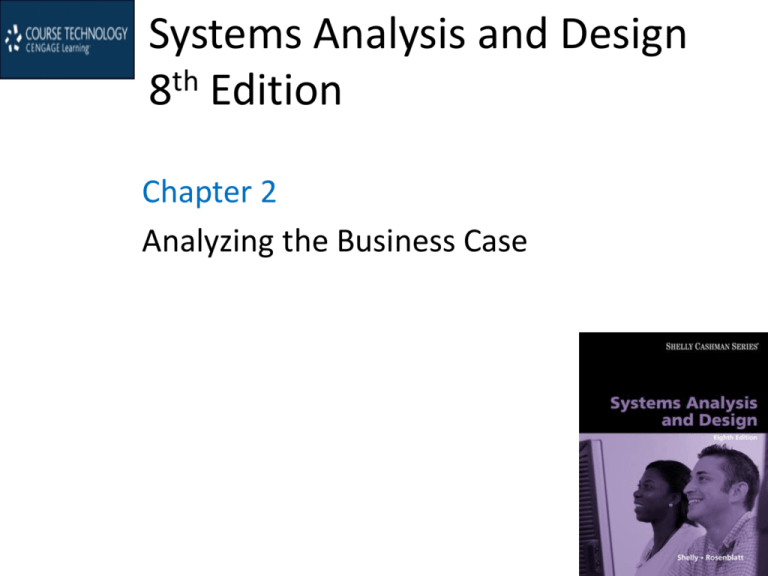
Systems Analysis and Design 8th Edition Chapter 2 Analyzing the Business Case Chapter Objectives • Explain the concept of a business case and how a business case affects an IT project • Describe the strategic planning process and why it is important to the IT team • Conduct a SWOT analysis and describe the four factors involved 2 Chapter Objectives • Explain the purpose of a mission statement • Describe the SDLC, and explain how it serves as a framework for systems development and business modeling • List the reasons for information systems projects and the factors that affect such projects 3 Chapter Objectives • Explain the initial review of systems requests and the role of the systems review committee • Define operational feasibility, technical feasibility, economic feasibility, and schedule feasibility • Describe the steps in a preliminary investigation and the end product of an investigation 4 Introduction • The term business case refers to the reasons, or justification, for a proposal • A strong business case suggests that the company should pursue the alternative, above other options, because it would be in the firm’s best interest to do so • Systems development typically starts with a systems request, followed by a preliminary investigation, which includes a feasibility study 5 Strategic Planning – A Framework for IT Systems Development • Strategic Planning Overview – SWOT analysis 6 Strategic Planning – A Framework for IT Systems Development • From Strategic Plans to Business Results – – – – Mission statement Stakeholders Goals Objectives 7 Strategic Planning – A Framework for IT Systems Development • A CASE Tool Example – You are a systems analyst – You research the Visible Analyst CASE tool – Planning statements can include assumptions, goals, objectives, and critical success factors, and many other types of statements 8 Strategic Planning – A Framework for IT Systems Development • The Role of the IT Department in Project Evaluation – Management leadership and information technology are linked closely, and remarkable changes have occurred in both areas – Today, systems development is much more team oriented – Although team-oriented development is the norm, some companies see the role of the IT department as a gatekeeper 9 Strategic Planning – A Framework for IT Systems Development • The Future – If you could look into the future, here is what you might see: new industries, products, and services emerging from amazing advances in information technology, customers who expect world-class IT support, a surge in Internet-based commerce, and a global business environment that is dynamic and incredibly challenging 10 What Is a Business Case? • Should be comprehensive, yet easy to understand • Should describe the project clearly, provide the justification to proceed, and estimate the project’s financial impact 11 Information Systems Projects • Main Reasons for Systems Projects 12 Information Systems Projects • Factors that Affect Systems Projects 13 Information Systems Projects • Project Management – If the project is approved, it can be planned, scheduled, monitored and controlled, and reported upon – Individual analysts or IT staff members often handle small projects, but companies usually designate a project manager to coordinate the overall effort for complex projects 14 Evaluation of Systems Requests • Systems review committee or a computer resources committee evaluate systems requests • Systems Requests Forms – A properly designed form streamlines the request process and ensures consistency – Occasionally a situation will arise that requires an immediate response 15 Evaluation of Systems Requests • Systems Review Committees – Most large companies use a systems review committee to evaluate systems requests – Many smaller companies rely on one person to evaluate systems requests instead of a committee – The goal is to evaluate the requests and set priorities 16 Overview of Feasibility • A systems request must pass several tests, called a feasibility study, to see whether it is worthwhile to proceed further • Operational Feasibility – Depends on several vital issues 17 Overview of Feasibility • Technical Feasibility • Economic Feasibility – Total cost of ownership (TCO) – Tangible benefits – Intangible benefits • Schedule Feasibility 18 Evaluating Feasibility • The first step in evaluating feasibility is to identify and weed out systems requests that are not feasible • Even if the request is feasible, it might not be necessary • Feasibility analysis is an ongoing task that must be performed throughout the systems development process 19 Setting Priorities • Factors that Affect Priority – Will the proposed system reduce costs? Where? When? How? How much? – Will the system increase revenue for the company? Where? When? How? How much? 20 Setting Priorities • Factors that Affect Priority – Will the systems project result in more information or produce better results? How? Are the results measurable? – Will the system serve customers better? – Will the system serve the organization better? 21 Setting Priorities • Factors that Affect Priority – Can the project be implemented in a reasonable time period? How long will the results last? – Are the necessary financial, human, and technical resources available? – Whenever possible, the analyst should evaluate a proposed project based on tangible costs and benefits that represent actual (or approximate) dollar values 22 Setting Priorities • Discretionary and Nondiscretionary Projects – Projects where management has a choice in implementing them are called discretionary projects – Projects where no choice exists are called nondiscretionary projects 23 Preliminary Investigation Overview • Preliminary investigation • Interaction with Managers and Users – Let people know about the investigation and explain your role – Employee attitudes and reactions are important and must be considered – Be careful in your use of the word problem – Question users about additional capability they would like to have 24 Preliminary Investigation Overview • Planning the Preliminary Investigation – During a preliminary investigation, a systems analyst typically follows a series of steps – The exact procedure depends on the nature of the request, the size of the project, and the degree of urgency 25 Preliminary Investigation Overview • Step 1: Understand the Problem or Opportunity – A popular technique for investigating causes and effects is called a fishbone diagram, or Ishikawa diagram – Pareto chart 26 Preliminary Investigation Overview • Step 2: Define the Project Scope and Constraints – Project scope – Project creep – Constraint 27 Preliminary Investigation Overview • Step 2: Define the Project Scope and Constraints – Present versus future – Internal versus external – Mandatory versus desirable – Regardless of the type, all constraints should be identified as early as possible to avoid future problems and surprises 28 Preliminary Investigation Overview • Step 3: Perform Fact-Finding – Fact-finding involves various techniques – Depending on what information is needed to investigate the systems request, fact-finding might consume several hours, days, or weeks – Analyze Organization Charts • Obtain organization charts to understand how the department functions and identify individuals you might want to interview 29 Preliminary Investigation Overview • Step 3: Perform FactFinding – – – – Conduct interviews Review documentation Observe operations Conduct a user survey 30 Preliminary Investigation Overview • Step 4: Analyze Project Usability, Cost, Benefit, and Schedule Data – Before you can evaluate feasibility, you must analyze this data carefully – What information must you obtain, and how will you gather and analyze the information? – What sources of information will you use, and what difficulties will you encounter in obtaining information? 31 Preliminary Investigation Overview • Step 4: Analyze Project Usability, Cost, Benefit, and Schedule Data – Will you conduct interviews? How many people will you interview, and how much time will you need to meet with the people and summarize their responses? – Will you conduct a survey? Who will be involved? How much time will it take people to complete it? How much time will it take to prepare it and tabulate the results? 32 Preliminary Investigation Overview • Step 4: Analyze Project Usability, Cost, Benefit, and Schedule Data – How much will it cost to analyze the information gathered and to prepare a report with findings and recommendations? 33 Preliminary Investigation Overview • Step 5: Evaluate Feasibility – Start by reviewing the answers to the questions you asked – Operational feasibility – Technical feasibility – Economic feasibility – Schedule feasibility 34 Preliminary Investigation Overview • Step 6: Present Results and Recommendations to Management – The final task in the preliminary investigation is to prepare a report to management – The format of the preliminary investigation report varies from one company to another 35 Preliminary Investigation Overview • Step 6: Present Results and Recommendations to Management • Introduction • Systems request summary • Findings • Case for action 36 Preliminary Investigation Overview • Step 6: Present Results and Recommendations to Management • • • • Project Roles Time & cost estimates Expected benefits Appendix 37 Chapter Summary • Strategic planning allows a company to examine its purpose, vision, and values and develops a mission statement, which leads to goals, objectives, day-to-day operations, and business results that affect company stakeholders • Systems projects are initiated to improve performance, provide more information, reduce costs, strengthen controls, or provide better service 38 Chapter Summary • Various internal and external factors affect systems projects, such as user requests, top management directives, existing systems, the IT department, software and hardware vendors, technology, customers, competitors, the economy, and government • During the preliminary investigation, the analyst evaluates the systems request and determines whether the project is feasible from an operation, technical, economic, and schedule standpoint 39 Chapter Summary • Analysts evaluate systems requests on the basis of their expected costs and benefits, both tangible and intangible • The steps in the preliminary investigation are to understand the problem or opportunity; define the project scope and constraints; perform factfinding; analyze project usability, cost, benefit, and schedule data; evaluate feasibility; and present results and recommendations to management 40 Chapter Summary • The last task in a preliminary investigation is to prepare a report to management • The report must include an estimate of time, staffing requirements, costs, benefits, and expected results for the next phase of the SDLC • Chapter 2 complete 41
